Business Administration Report: Detailed Examination of Selected Units
VerifiedAdded on 2020/07/22
|21
|5848
|51
Report
AI Summary
This report provides a comprehensive overview of various units within business administration. It begins with an introduction to business administration, emphasizing the importance of effective decision-making and operational procedures. The report then delves into specific units, starting with Unit 10, which focuses on presentation skills, including crafting a central message, understanding the sales process, and creating engaging presentations. Unit 11 covers office management, highlighting the importance of employee productivity, facility management, and creating a productive work environment. Unit 19 discusses mail handling procedures, including safety, security, and the use of franking machines. Subsequent units, although not fully detailed in the provided text, likely address additional aspects of business administration, such as administrative services, and supplier relationship management. The report concludes with a summary of key concepts and references relevant sources.
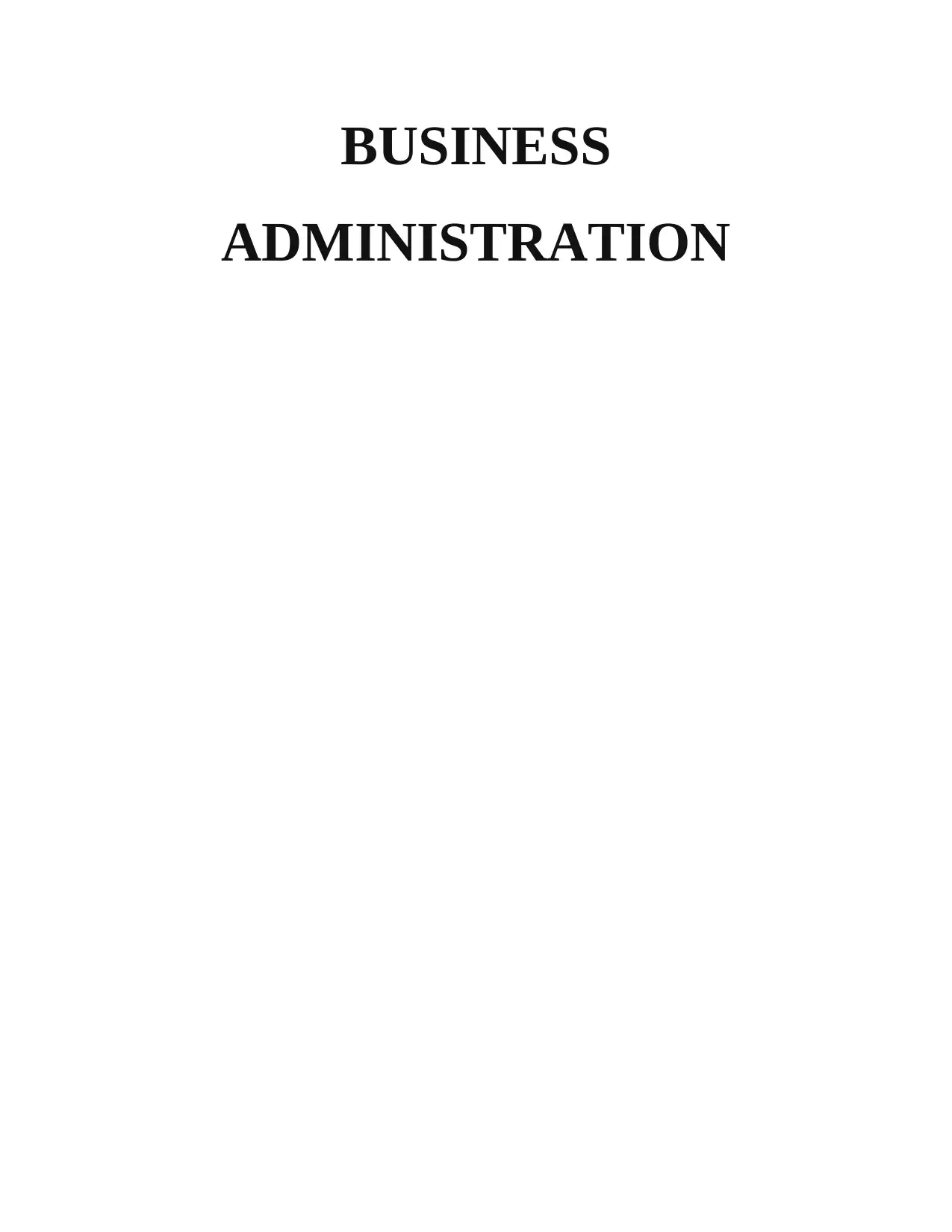
BUSINESS
ADMINISTRATION
ADMINISTRATION
Paraphrase This Document
Need a fresh take? Get an instant paraphrase of this document with our AI Paraphraser
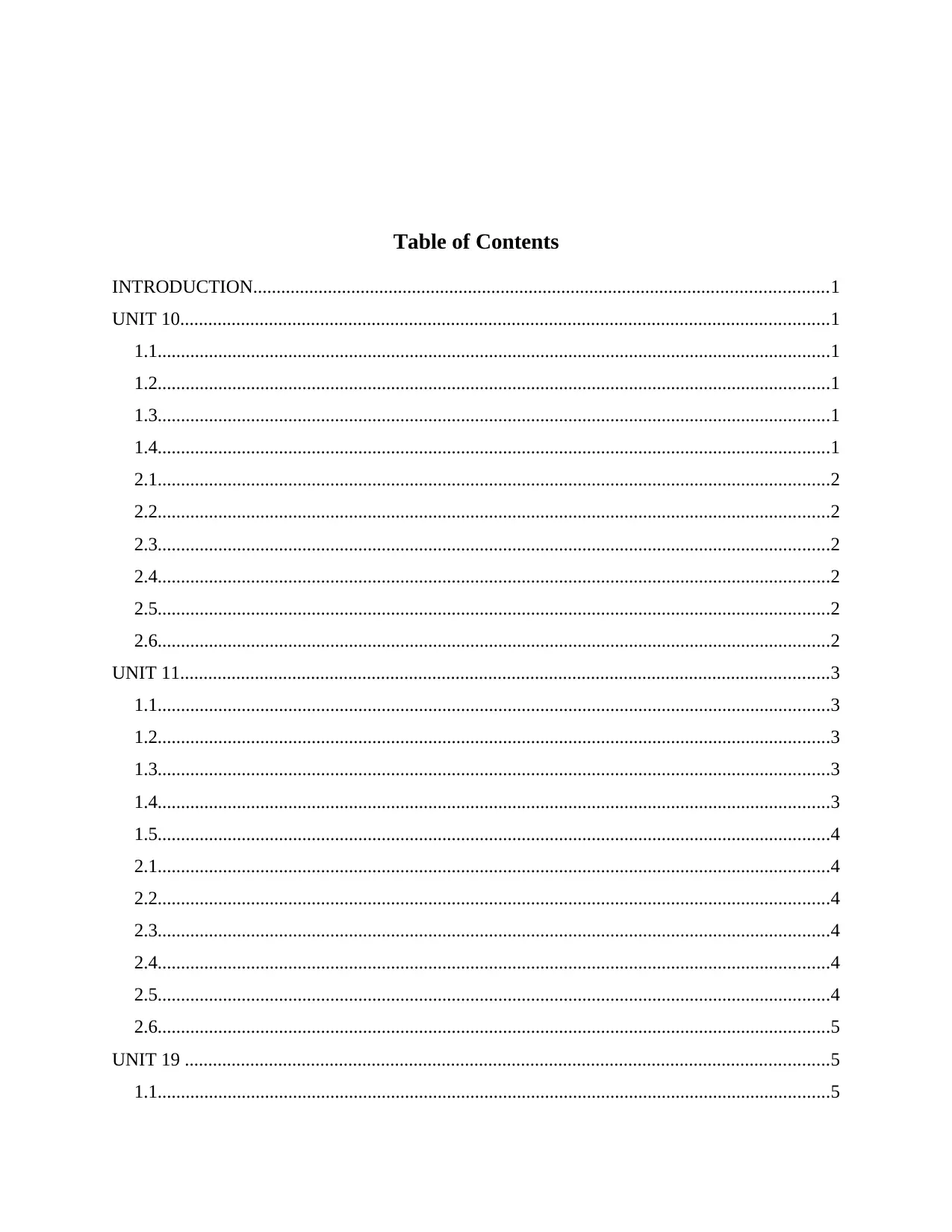
Table of Contents
INTRODUCTION...........................................................................................................................1
UNIT 10...........................................................................................................................................1
1.1................................................................................................................................................1
1.2................................................................................................................................................1
1.3................................................................................................................................................1
1.4................................................................................................................................................1
2.1................................................................................................................................................2
2.2................................................................................................................................................2
2.3................................................................................................................................................2
2.4................................................................................................................................................2
2.5................................................................................................................................................2
2.6................................................................................................................................................2
UNIT 11...........................................................................................................................................3
1.1................................................................................................................................................3
1.2................................................................................................................................................3
1.3................................................................................................................................................3
1.4................................................................................................................................................3
1.5................................................................................................................................................4
2.1................................................................................................................................................4
2.2................................................................................................................................................4
2.3................................................................................................................................................4
2.4................................................................................................................................................4
2.5................................................................................................................................................4
2.6................................................................................................................................................5
UNIT 19 ..........................................................................................................................................5
1.1................................................................................................................................................5
INTRODUCTION...........................................................................................................................1
UNIT 10...........................................................................................................................................1
1.1................................................................................................................................................1
1.2................................................................................................................................................1
1.3................................................................................................................................................1
1.4................................................................................................................................................1
2.1................................................................................................................................................2
2.2................................................................................................................................................2
2.3................................................................................................................................................2
2.4................................................................................................................................................2
2.5................................................................................................................................................2
2.6................................................................................................................................................2
UNIT 11...........................................................................................................................................3
1.1................................................................................................................................................3
1.2................................................................................................................................................3
1.3................................................................................................................................................3
1.4................................................................................................................................................3
1.5................................................................................................................................................4
2.1................................................................................................................................................4
2.2................................................................................................................................................4
2.3................................................................................................................................................4
2.4................................................................................................................................................4
2.5................................................................................................................................................4
2.6................................................................................................................................................5
UNIT 19 ..........................................................................................................................................5
1.1................................................................................................................................................5
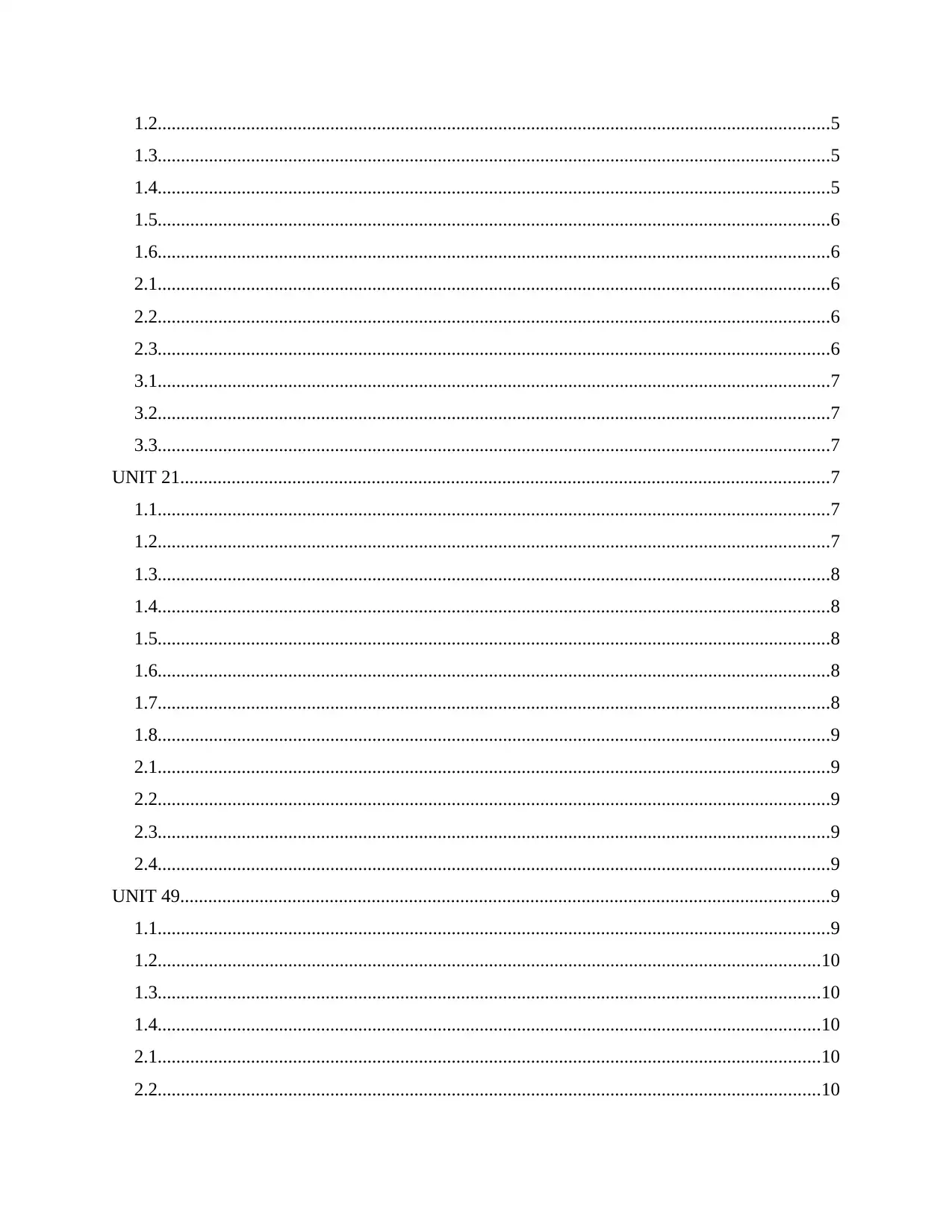
1.2................................................................................................................................................5
1.3................................................................................................................................................5
1.4................................................................................................................................................5
1.5................................................................................................................................................6
1.6................................................................................................................................................6
2.1................................................................................................................................................6
2.2................................................................................................................................................6
2.3................................................................................................................................................6
3.1................................................................................................................................................7
3.2................................................................................................................................................7
3.3................................................................................................................................................7
UNIT 21...........................................................................................................................................7
1.1................................................................................................................................................7
1.2................................................................................................................................................7
1.3................................................................................................................................................8
1.4................................................................................................................................................8
1.5................................................................................................................................................8
1.6................................................................................................................................................8
1.7................................................................................................................................................8
1.8................................................................................................................................................9
2.1................................................................................................................................................9
2.2................................................................................................................................................9
2.3................................................................................................................................................9
2.4................................................................................................................................................9
UNIT 49...........................................................................................................................................9
1.1................................................................................................................................................9
1.2..............................................................................................................................................10
1.3..............................................................................................................................................10
1.4..............................................................................................................................................10
2.1..............................................................................................................................................10
2.2..............................................................................................................................................10
1.3................................................................................................................................................5
1.4................................................................................................................................................5
1.5................................................................................................................................................6
1.6................................................................................................................................................6
2.1................................................................................................................................................6
2.2................................................................................................................................................6
2.3................................................................................................................................................6
3.1................................................................................................................................................7
3.2................................................................................................................................................7
3.3................................................................................................................................................7
UNIT 21...........................................................................................................................................7
1.1................................................................................................................................................7
1.2................................................................................................................................................7
1.3................................................................................................................................................8
1.4................................................................................................................................................8
1.5................................................................................................................................................8
1.6................................................................................................................................................8
1.7................................................................................................................................................8
1.8................................................................................................................................................9
2.1................................................................................................................................................9
2.2................................................................................................................................................9
2.3................................................................................................................................................9
2.4................................................................................................................................................9
UNIT 49...........................................................................................................................................9
1.1................................................................................................................................................9
1.2..............................................................................................................................................10
1.3..............................................................................................................................................10
1.4..............................................................................................................................................10
2.1..............................................................................................................................................10
2.2..............................................................................................................................................10
⊘ This is a preview!⊘
Do you want full access?
Subscribe today to unlock all pages.

Trusted by 1+ million students worldwide
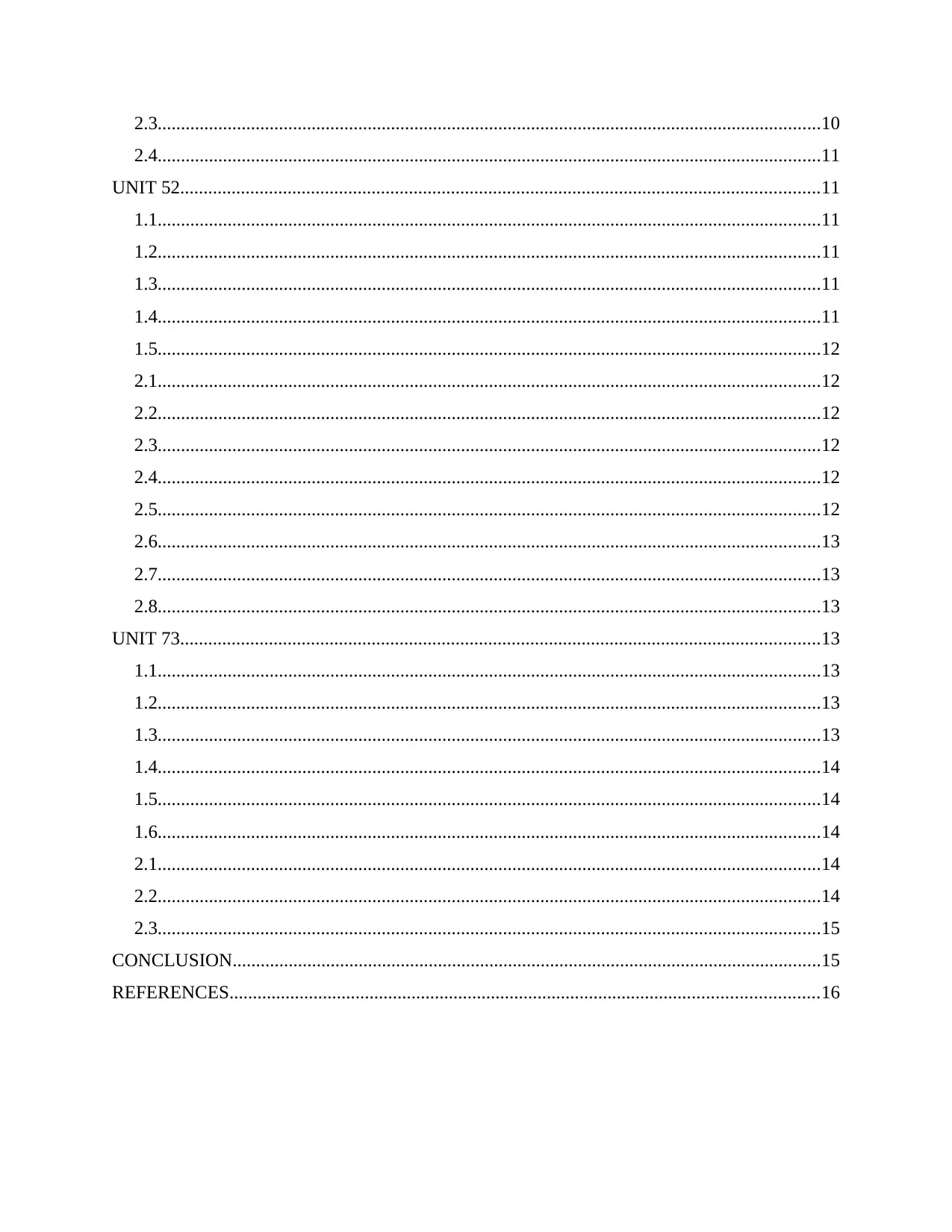
2.3..............................................................................................................................................10
2.4..............................................................................................................................................11
UNIT 52.........................................................................................................................................11
1.1..............................................................................................................................................11
1.2..............................................................................................................................................11
1.3..............................................................................................................................................11
1.4..............................................................................................................................................11
1.5..............................................................................................................................................12
2.1..............................................................................................................................................12
2.2..............................................................................................................................................12
2.3..............................................................................................................................................12
2.4..............................................................................................................................................12
2.5..............................................................................................................................................12
2.6..............................................................................................................................................13
2.7..............................................................................................................................................13
2.8..............................................................................................................................................13
UNIT 73.........................................................................................................................................13
1.1..............................................................................................................................................13
1.2..............................................................................................................................................13
1.3..............................................................................................................................................13
1.4..............................................................................................................................................14
1.5..............................................................................................................................................14
1.6..............................................................................................................................................14
2.1..............................................................................................................................................14
2.2..............................................................................................................................................14
2.3..............................................................................................................................................15
CONCLUSION..............................................................................................................................15
REFERENCES..............................................................................................................................16
2.4..............................................................................................................................................11
UNIT 52.........................................................................................................................................11
1.1..............................................................................................................................................11
1.2..............................................................................................................................................11
1.3..............................................................................................................................................11
1.4..............................................................................................................................................11
1.5..............................................................................................................................................12
2.1..............................................................................................................................................12
2.2..............................................................................................................................................12
2.3..............................................................................................................................................12
2.4..............................................................................................................................................12
2.5..............................................................................................................................................12
2.6..............................................................................................................................................13
2.7..............................................................................................................................................13
2.8..............................................................................................................................................13
UNIT 73.........................................................................................................................................13
1.1..............................................................................................................................................13
1.2..............................................................................................................................................13
1.3..............................................................................................................................................13
1.4..............................................................................................................................................14
1.5..............................................................................................................................................14
1.6..............................................................................................................................................14
2.1..............................................................................................................................................14
2.2..............................................................................................................................................14
2.3..............................................................................................................................................15
CONCLUSION..............................................................................................................................15
REFERENCES..............................................................................................................................16
Paraphrase This Document
Need a fresh take? Get an instant paraphrase of this document with our AI Paraphraser
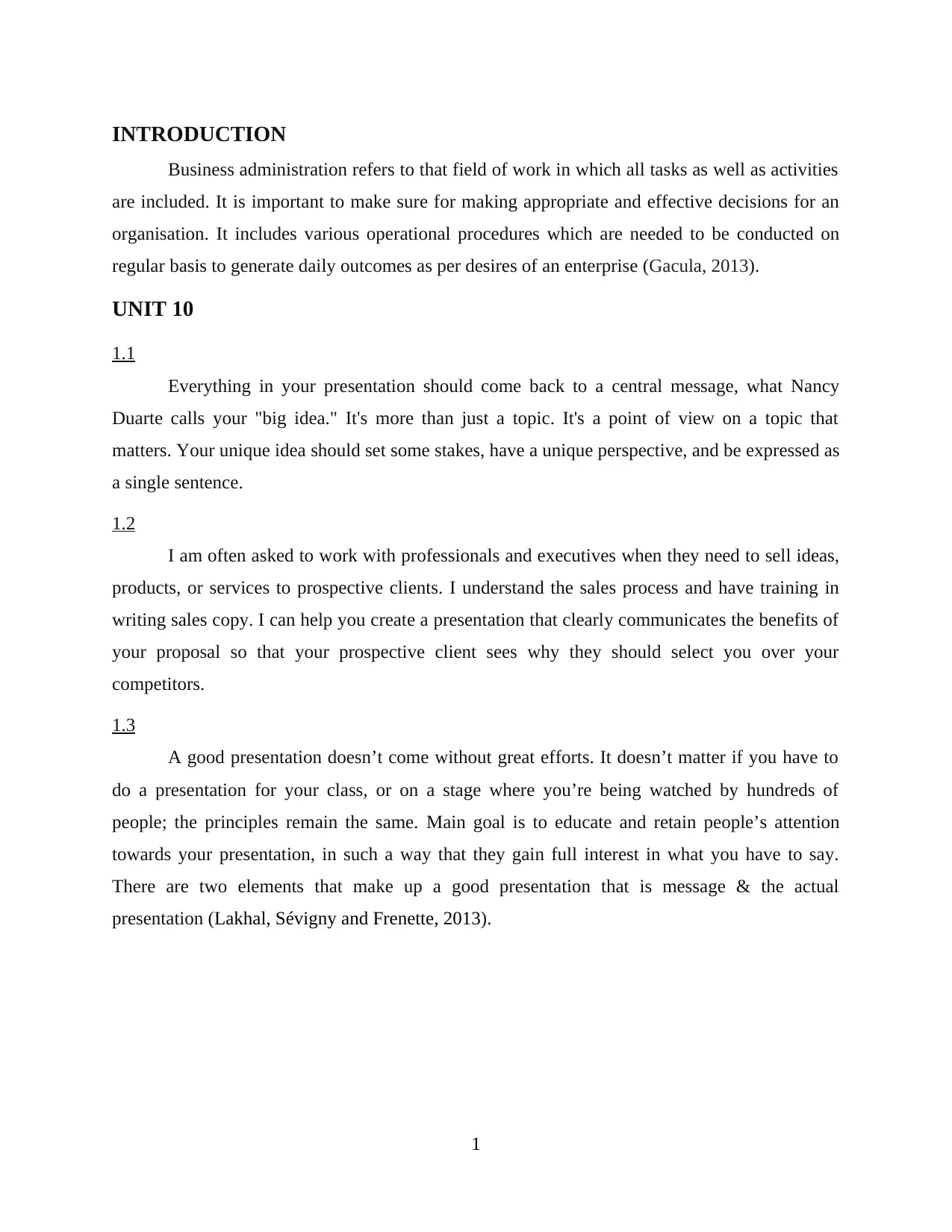
INTRODUCTION
Business administration refers to that field of work in which all tasks as well as activities
are included. It is important to make sure for making appropriate and effective decisions for an
organisation. It includes various operational procedures which are needed to be conducted on
regular basis to generate daily outcomes as per desires of an enterprise (Gacula, 2013).
UNIT 10
1.1
Everything in your presentation should come back to a central message, what Nancy
Duarte calls your "big idea." It's more than just a topic. It's a point of view on a topic that
matters. Your unique idea should set some stakes, have a unique perspective, and be expressed as
a single sentence.
1.2
I am often asked to work with professionals and executives when they need to sell ideas,
products, or services to prospective clients. I understand the sales process and have training in
writing sales copy. I can help you create a presentation that clearly communicates the benefits of
your proposal so that your prospective client sees why they should select you over your
competitors.
1.3
A good presentation doesn’t come without great efforts. It doesn’t matter if you have to
do a presentation for your class, or on a stage where you’re being watched by hundreds of
people; the principles remain the same. Main goal is to educate and retain people’s attention
towards your presentation, in such a way that they gain full interest in what you have to say.
There are two elements that make up a good presentation that is message & the actual
presentation (Lakhal, Sévigny and Frenette, 2013).
1
Business administration refers to that field of work in which all tasks as well as activities
are included. It is important to make sure for making appropriate and effective decisions for an
organisation. It includes various operational procedures which are needed to be conducted on
regular basis to generate daily outcomes as per desires of an enterprise (Gacula, 2013).
UNIT 10
1.1
Everything in your presentation should come back to a central message, what Nancy
Duarte calls your "big idea." It's more than just a topic. It's a point of view on a topic that
matters. Your unique idea should set some stakes, have a unique perspective, and be expressed as
a single sentence.
1.2
I am often asked to work with professionals and executives when they need to sell ideas,
products, or services to prospective clients. I understand the sales process and have training in
writing sales copy. I can help you create a presentation that clearly communicates the benefits of
your proposal so that your prospective client sees why they should select you over your
competitors.
1.3
A good presentation doesn’t come without great efforts. It doesn’t matter if you have to
do a presentation for your class, or on a stage where you’re being watched by hundreds of
people; the principles remain the same. Main goal is to educate and retain people’s attention
towards your presentation, in such a way that they gain full interest in what you have to say.
There are two elements that make up a good presentation that is message & the actual
presentation (Lakhal, Sévigny and Frenette, 2013).
1
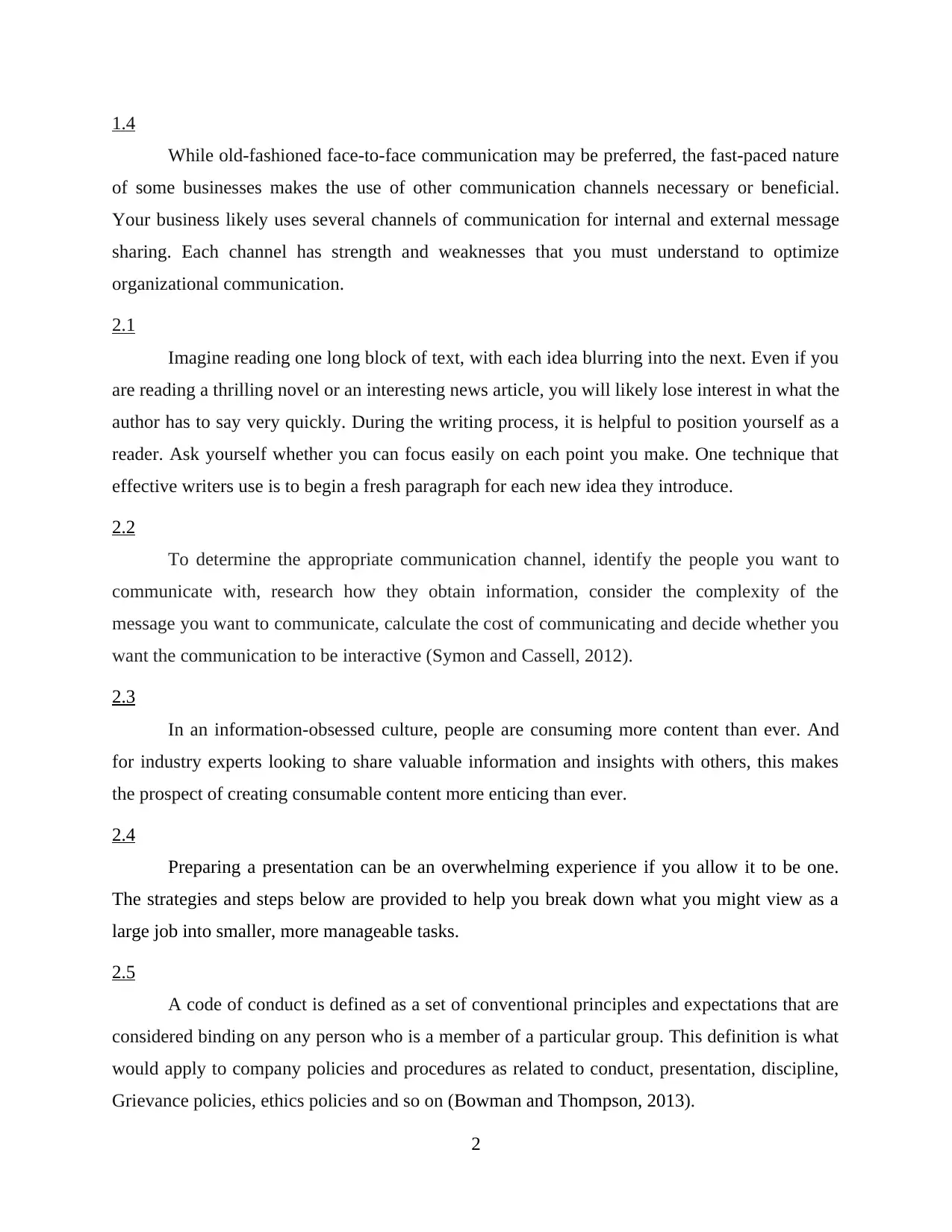
1.4
While old-fashioned face-to-face communication may be preferred, the fast-paced nature
of some businesses makes the use of other communication channels necessary or beneficial.
Your business likely uses several channels of communication for internal and external message
sharing. Each channel has strength and weaknesses that you must understand to optimize
organizational communication.
2.1
Imagine reading one long block of text, with each idea blurring into the next. Even if you
are reading a thrilling novel or an interesting news article, you will likely lose interest in what the
author has to say very quickly. During the writing process, it is helpful to position yourself as a
reader. Ask yourself whether you can focus easily on each point you make. One technique that
effective writers use is to begin a fresh paragraph for each new idea they introduce.
2.2
To determine the appropriate communication channel, identify the people you want to
communicate with, research how they obtain information, consider the complexity of the
message you want to communicate, calculate the cost of communicating and decide whether you
want the communication to be interactive (Symon and Cassell, 2012).
2.3
In an information-obsessed culture, people are consuming more content than ever. And
for industry experts looking to share valuable information and insights with others, this makes
the prospect of creating consumable content more enticing than ever.
2.4
Preparing a presentation can be an overwhelming experience if you allow it to be one.
The strategies and steps below are provided to help you break down what you might view as a
large job into smaller, more manageable tasks.
2.5
A code of conduct is defined as a set of conventional principles and expectations that are
considered binding on any person who is a member of a particular group. This definition is what
would apply to company policies and procedures as related to conduct, presentation, discipline,
Grievance policies, ethics policies and so on (Bowman and Thompson, 2013).
2
While old-fashioned face-to-face communication may be preferred, the fast-paced nature
of some businesses makes the use of other communication channels necessary or beneficial.
Your business likely uses several channels of communication for internal and external message
sharing. Each channel has strength and weaknesses that you must understand to optimize
organizational communication.
2.1
Imagine reading one long block of text, with each idea blurring into the next. Even if you
are reading a thrilling novel or an interesting news article, you will likely lose interest in what the
author has to say very quickly. During the writing process, it is helpful to position yourself as a
reader. Ask yourself whether you can focus easily on each point you make. One technique that
effective writers use is to begin a fresh paragraph for each new idea they introduce.
2.2
To determine the appropriate communication channel, identify the people you want to
communicate with, research how they obtain information, consider the complexity of the
message you want to communicate, calculate the cost of communicating and decide whether you
want the communication to be interactive (Symon and Cassell, 2012).
2.3
In an information-obsessed culture, people are consuming more content than ever. And
for industry experts looking to share valuable information and insights with others, this makes
the prospect of creating consumable content more enticing than ever.
2.4
Preparing a presentation can be an overwhelming experience if you allow it to be one.
The strategies and steps below are provided to help you break down what you might view as a
large job into smaller, more manageable tasks.
2.5
A code of conduct is defined as a set of conventional principles and expectations that are
considered binding on any person who is a member of a particular group. This definition is what
would apply to company policies and procedures as related to conduct, presentation, discipline,
Grievance policies, ethics policies and so on (Bowman and Thompson, 2013).
2
⊘ This is a preview!⊘
Do you want full access?
Subscribe today to unlock all pages.

Trusted by 1+ million students worldwide
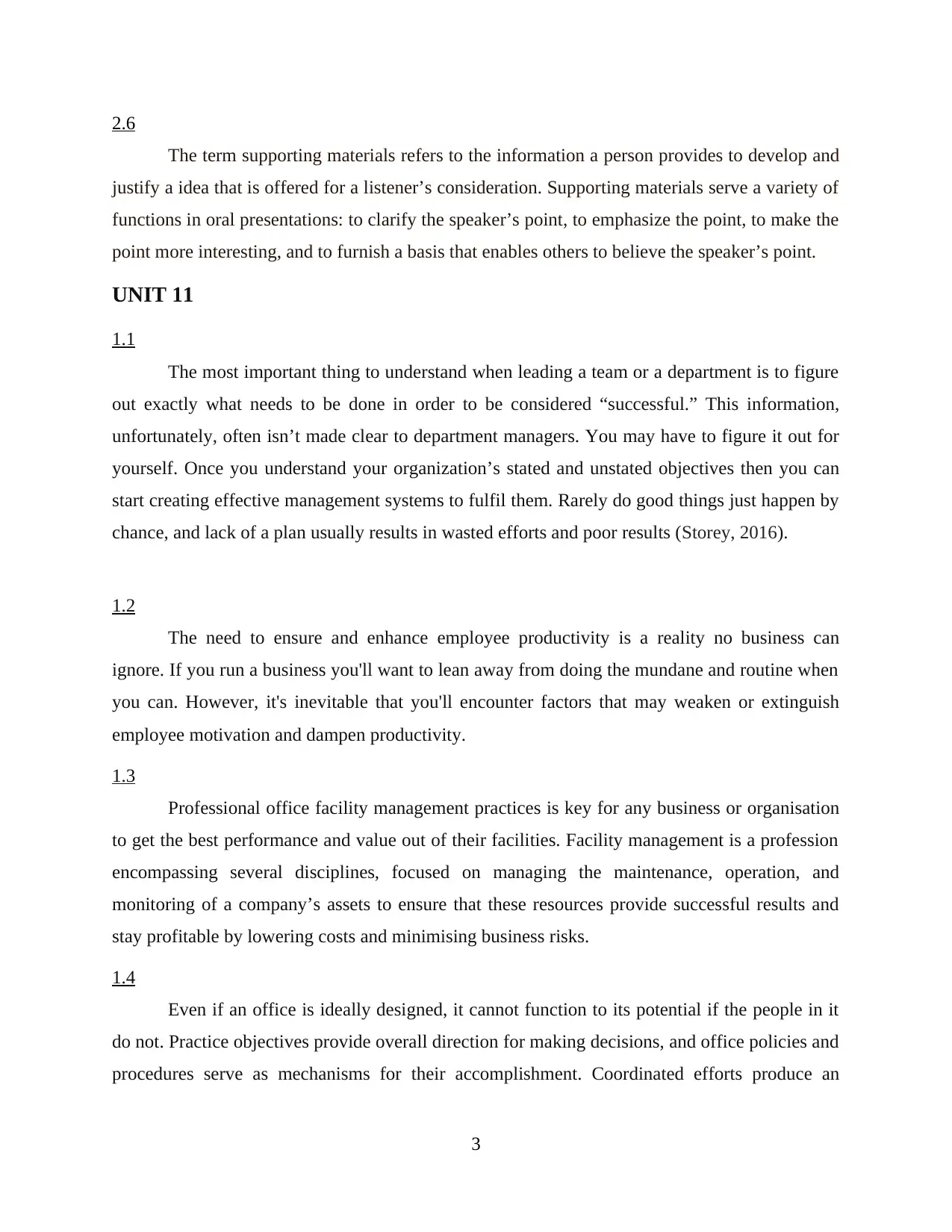
2.6
The term supporting materials refers to the information a person provides to develop and
justify a idea that is offered for a listener’s consideration. Supporting materials serve a variety of
functions in oral presentations: to clarify the speaker’s point, to emphasize the point, to make the
point more interesting, and to furnish a basis that enables others to believe the speaker’s point.
UNIT 11
1.1
The most important thing to understand when leading a team or a department is to figure
out exactly what needs to be done in order to be considered “successful.” This information,
unfortunately, often isn’t made clear to department managers. You may have to figure it out for
yourself. Once you understand your organization’s stated and unstated objectives then you can
start creating effective management systems to fulfil them. Rarely do good things just happen by
chance, and lack of a plan usually results in wasted efforts and poor results (Storey, 2016).
1.2
The need to ensure and enhance employee productivity is a reality no business can
ignore. If you run a business you'll want to lean away from doing the mundane and routine when
you can. However, it's inevitable that you'll encounter factors that may weaken or extinguish
employee motivation and dampen productivity.
1.3
Professional office facility management practices is key for any business or organisation
to get the best performance and value out of their facilities. Facility management is a profession
encompassing several disciplines, focused on managing the maintenance, operation, and
monitoring of a company’s assets to ensure that these resources provide successful results and
stay profitable by lowering costs and minimising business risks.
1.4
Even if an office is ideally designed, it cannot function to its potential if the people in it
do not. Practice objectives provide overall direction for making decisions, and office policies and
procedures serve as mechanisms for their accomplishment. Coordinated efforts produce an
3
The term supporting materials refers to the information a person provides to develop and
justify a idea that is offered for a listener’s consideration. Supporting materials serve a variety of
functions in oral presentations: to clarify the speaker’s point, to emphasize the point, to make the
point more interesting, and to furnish a basis that enables others to believe the speaker’s point.
UNIT 11
1.1
The most important thing to understand when leading a team or a department is to figure
out exactly what needs to be done in order to be considered “successful.” This information,
unfortunately, often isn’t made clear to department managers. You may have to figure it out for
yourself. Once you understand your organization’s stated and unstated objectives then you can
start creating effective management systems to fulfil them. Rarely do good things just happen by
chance, and lack of a plan usually results in wasted efforts and poor results (Storey, 2016).
1.2
The need to ensure and enhance employee productivity is a reality no business can
ignore. If you run a business you'll want to lean away from doing the mundane and routine when
you can. However, it's inevitable that you'll encounter factors that may weaken or extinguish
employee motivation and dampen productivity.
1.3
Professional office facility management practices is key for any business or organisation
to get the best performance and value out of their facilities. Facility management is a profession
encompassing several disciplines, focused on managing the maintenance, operation, and
monitoring of a company’s assets to ensure that these resources provide successful results and
stay profitable by lowering costs and minimising business risks.
1.4
Even if an office is ideally designed, it cannot function to its potential if the people in it
do not. Practice objectives provide overall direction for making decisions, and office policies and
procedures serve as mechanisms for their accomplishment. Coordinated efforts produce an
3
Paraphrase This Document
Need a fresh take? Get an instant paraphrase of this document with our AI Paraphraser
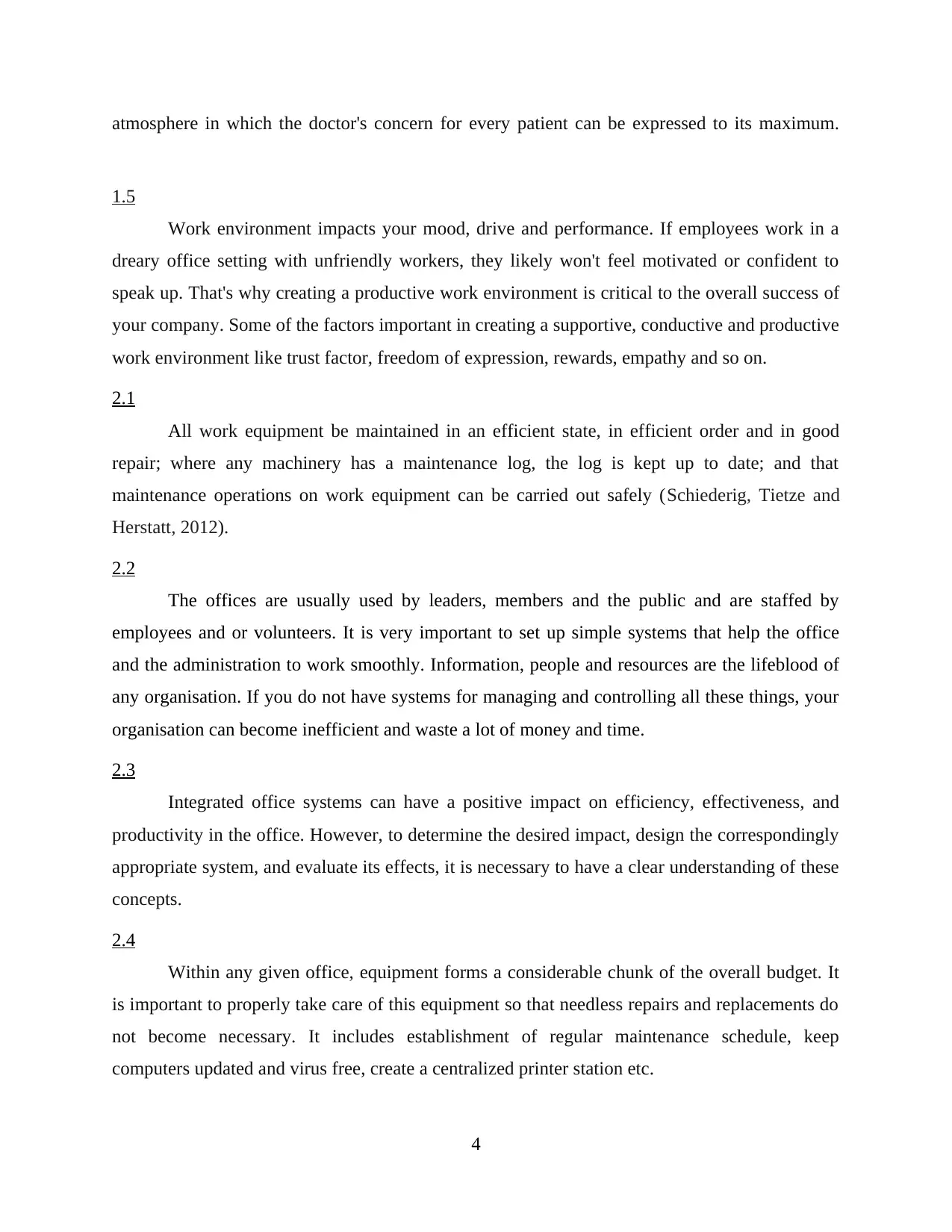
atmosphere in which the doctor's concern for every patient can be expressed to its maximum.
1.5
Work environment impacts your mood, drive and performance. If employees work in a
dreary office setting with unfriendly workers, they likely won't feel motivated or confident to
speak up. That's why creating a productive work environment is critical to the overall success of
your company. Some of the factors important in creating a supportive, conductive and productive
work environment like trust factor, freedom of expression, rewards, empathy and so on.
2.1
All work equipment be maintained in an efficient state, in efficient order and in good
repair; where any machinery has a maintenance log, the log is kept up to date; and that
maintenance operations on work equipment can be carried out safely (Schiederig, Tietze and
Herstatt, 2012).
2.2
The offices are usually used by leaders, members and the public and are staffed by
employees and or volunteers. It is very important to set up simple systems that help the office
and the administration to work smoothly. Information, people and resources are the lifeblood of
any organisation. If you do not have systems for managing and controlling all these things, your
organisation can become inefficient and waste a lot of money and time.
2.3
Integrated office systems can have a positive impact on efficiency, effectiveness, and
productivity in the office. However, to determine the desired impact, design the correspondingly
appropriate system, and evaluate its effects, it is necessary to have a clear understanding of these
concepts.
2.4
Within any given office, equipment forms a considerable chunk of the overall budget. It
is important to properly take care of this equipment so that needless repairs and replacements do
not become necessary. It includes establishment of regular maintenance schedule, keep
computers updated and virus free, create a centralized printer station etc.
4
1.5
Work environment impacts your mood, drive and performance. If employees work in a
dreary office setting with unfriendly workers, they likely won't feel motivated or confident to
speak up. That's why creating a productive work environment is critical to the overall success of
your company. Some of the factors important in creating a supportive, conductive and productive
work environment like trust factor, freedom of expression, rewards, empathy and so on.
2.1
All work equipment be maintained in an efficient state, in efficient order and in good
repair; where any machinery has a maintenance log, the log is kept up to date; and that
maintenance operations on work equipment can be carried out safely (Schiederig, Tietze and
Herstatt, 2012).
2.2
The offices are usually used by leaders, members and the public and are staffed by
employees and or volunteers. It is very important to set up simple systems that help the office
and the administration to work smoothly. Information, people and resources are the lifeblood of
any organisation. If you do not have systems for managing and controlling all these things, your
organisation can become inefficient and waste a lot of money and time.
2.3
Integrated office systems can have a positive impact on efficiency, effectiveness, and
productivity in the office. However, to determine the desired impact, design the correspondingly
appropriate system, and evaluate its effects, it is necessary to have a clear understanding of these
concepts.
2.4
Within any given office, equipment forms a considerable chunk of the overall budget. It
is important to properly take care of this equipment so that needless repairs and replacements do
not become necessary. It includes establishment of regular maintenance schedule, keep
computers updated and virus free, create a centralized printer station etc.
4
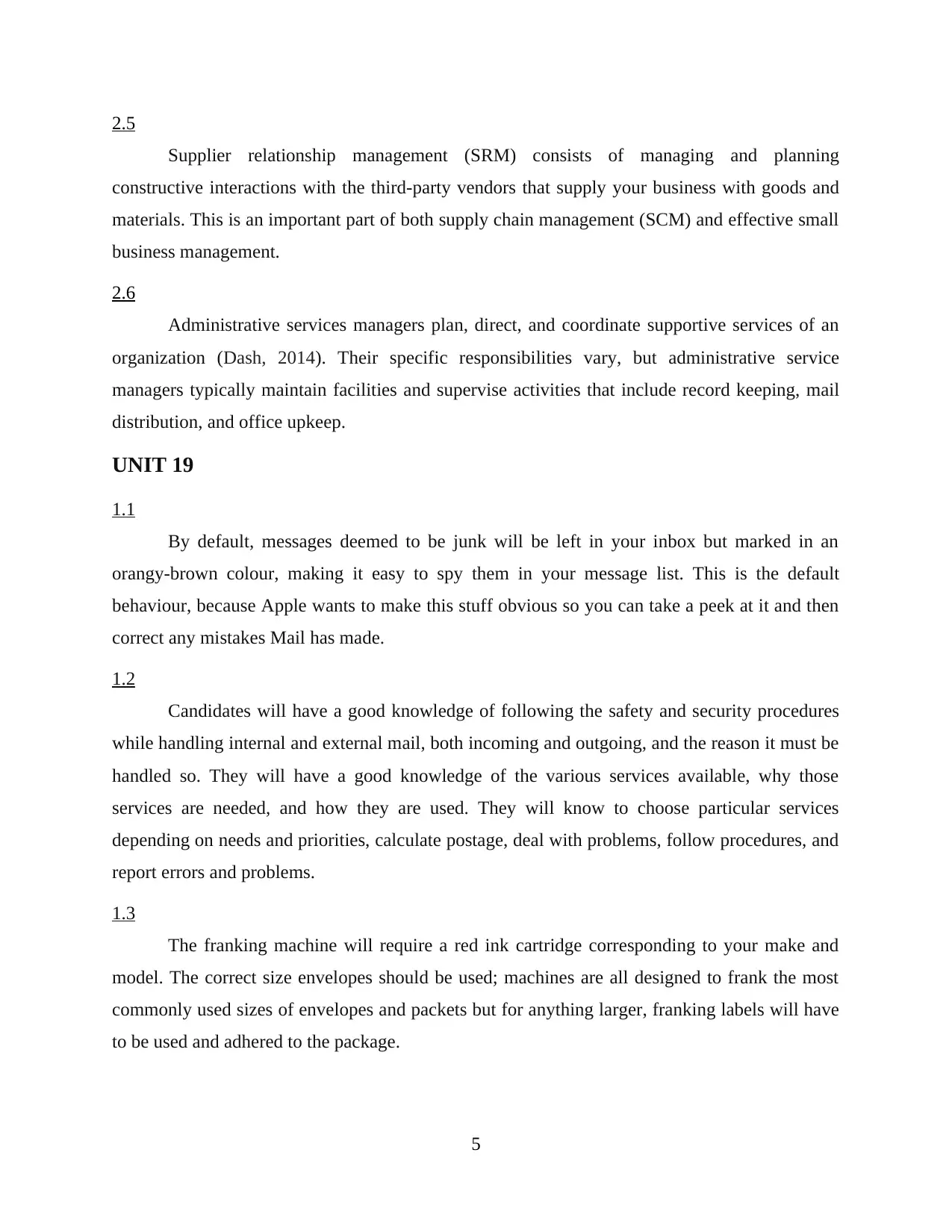
2.5
Supplier relationship management (SRM) consists of managing and planning
constructive interactions with the third-party vendors that supply your business with goods and
materials. This is an important part of both supply chain management (SCM) and effective small
business management.
2.6
Administrative services managers plan, direct, and coordinate supportive services of an
organization (Dash, 2014). Their specific responsibilities vary, but administrative service
managers typically maintain facilities and supervise activities that include record keeping, mail
distribution, and office upkeep.
UNIT 19
1.1
By default, messages deemed to be junk will be left in your inbox but marked in an
orangy-brown colour, making it easy to spy them in your message list. This is the default
behaviour, because Apple wants to make this stuff obvious so you can take a peek at it and then
correct any mistakes Mail has made.
1.2
Candidates will have a good knowledge of following the safety and security procedures
while handling internal and external mail, both incoming and outgoing, and the reason it must be
handled so. They will have a good knowledge of the various services available, why those
services are needed, and how they are used. They will know to choose particular services
depending on needs and priorities, calculate postage, deal with problems, follow procedures, and
report errors and problems.
1.3
The franking machine will require a red ink cartridge corresponding to your make and
model. The correct size envelopes should be used; machines are all designed to frank the most
commonly used sizes of envelopes and packets but for anything larger, franking labels will have
to be used and adhered to the package.
5
Supplier relationship management (SRM) consists of managing and planning
constructive interactions with the third-party vendors that supply your business with goods and
materials. This is an important part of both supply chain management (SCM) and effective small
business management.
2.6
Administrative services managers plan, direct, and coordinate supportive services of an
organization (Dash, 2014). Their specific responsibilities vary, but administrative service
managers typically maintain facilities and supervise activities that include record keeping, mail
distribution, and office upkeep.
UNIT 19
1.1
By default, messages deemed to be junk will be left in your inbox but marked in an
orangy-brown colour, making it easy to spy them in your message list. This is the default
behaviour, because Apple wants to make this stuff obvious so you can take a peek at it and then
correct any mistakes Mail has made.
1.2
Candidates will have a good knowledge of following the safety and security procedures
while handling internal and external mail, both incoming and outgoing, and the reason it must be
handled so. They will have a good knowledge of the various services available, why those
services are needed, and how they are used. They will know to choose particular services
depending on needs and priorities, calculate postage, deal with problems, follow procedures, and
report errors and problems.
1.3
The franking machine will require a red ink cartridge corresponding to your make and
model. The correct size envelopes should be used; machines are all designed to frank the most
commonly used sizes of envelopes and packets but for anything larger, franking labels will have
to be used and adhered to the package.
5
⊘ This is a preview!⊘
Do you want full access?
Subscribe today to unlock all pages.

Trusted by 1+ million students worldwide
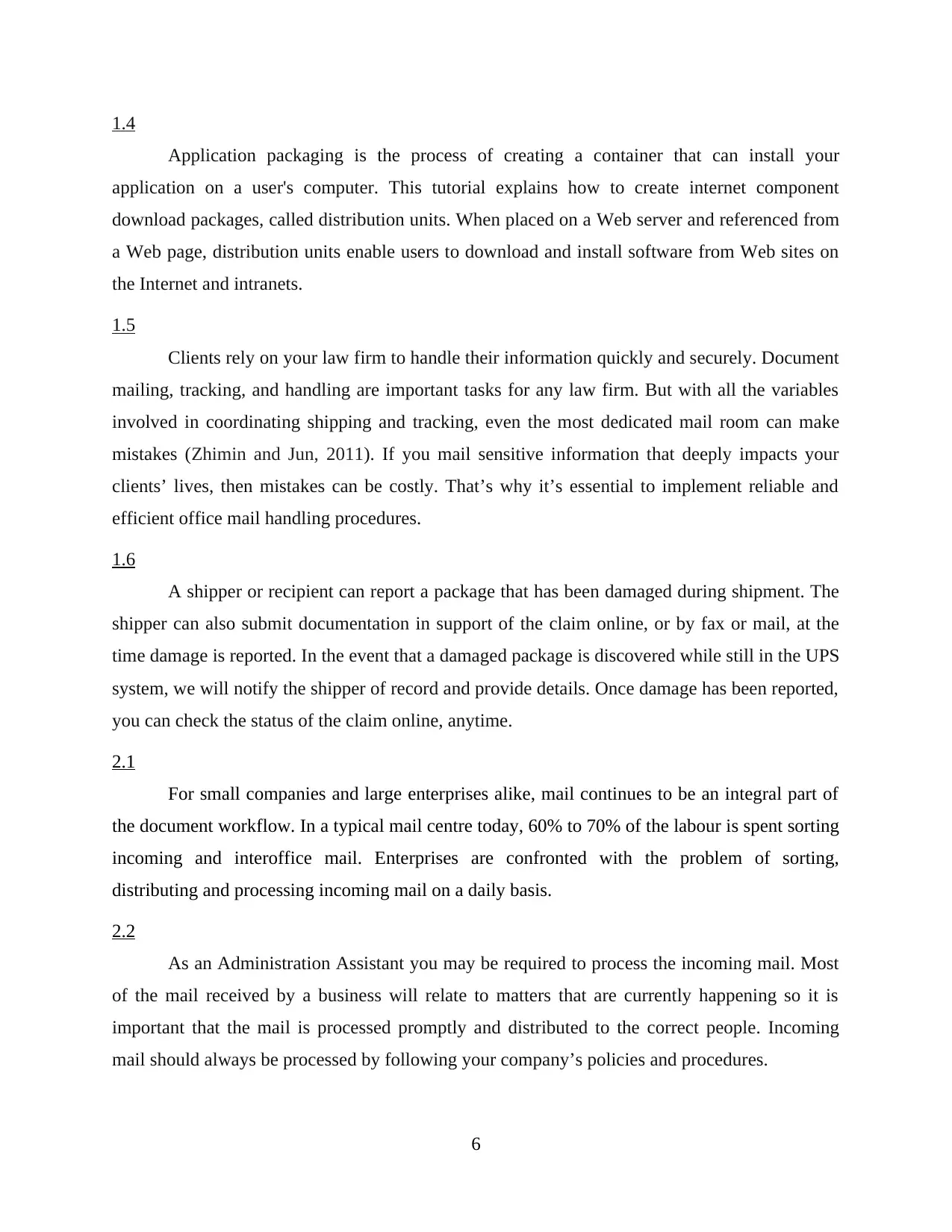
1.4
Application packaging is the process of creating a container that can install your
application on a user's computer. This tutorial explains how to create internet component
download packages, called distribution units. When placed on a Web server and referenced from
a Web page, distribution units enable users to download and install software from Web sites on
the Internet and intranets.
1.5
Clients rely on your law firm to handle their information quickly and securely. Document
mailing, tracking, and handling are important tasks for any law firm. But with all the variables
involved in coordinating shipping and tracking, even the most dedicated mail room can make
mistakes (Zhimin and Jun, 2011). If you mail sensitive information that deeply impacts your
clients’ lives, then mistakes can be costly. That’s why it’s essential to implement reliable and
efficient office mail handling procedures.
1.6
A shipper or recipient can report a package that has been damaged during shipment. The
shipper can also submit documentation in support of the claim online, or by fax or mail, at the
time damage is reported. In the event that a damaged package is discovered while still in the UPS
system, we will notify the shipper of record and provide details. Once damage has been reported,
you can check the status of the claim online, anytime.
2.1
For small companies and large enterprises alike, mail continues to be an integral part of
the document workflow. In a typical mail centre today, 60% to 70% of the labour is spent sorting
incoming and interoffice mail. Enterprises are confronted with the problem of sorting,
distributing and processing incoming mail on a daily basis.
2.2
As an Administration Assistant you may be required to process the incoming mail. Most
of the mail received by a business will relate to matters that are currently happening so it is
important that the mail is processed promptly and distributed to the correct people. Incoming
mail should always be processed by following your company’s policies and procedures.
6
Application packaging is the process of creating a container that can install your
application on a user's computer. This tutorial explains how to create internet component
download packages, called distribution units. When placed on a Web server and referenced from
a Web page, distribution units enable users to download and install software from Web sites on
the Internet and intranets.
1.5
Clients rely on your law firm to handle their information quickly and securely. Document
mailing, tracking, and handling are important tasks for any law firm. But with all the variables
involved in coordinating shipping and tracking, even the most dedicated mail room can make
mistakes (Zhimin and Jun, 2011). If you mail sensitive information that deeply impacts your
clients’ lives, then mistakes can be costly. That’s why it’s essential to implement reliable and
efficient office mail handling procedures.
1.6
A shipper or recipient can report a package that has been damaged during shipment. The
shipper can also submit documentation in support of the claim online, or by fax or mail, at the
time damage is reported. In the event that a damaged package is discovered while still in the UPS
system, we will notify the shipper of record and provide details. Once damage has been reported,
you can check the status of the claim online, anytime.
2.1
For small companies and large enterprises alike, mail continues to be an integral part of
the document workflow. In a typical mail centre today, 60% to 70% of the labour is spent sorting
incoming and interoffice mail. Enterprises are confronted with the problem of sorting,
distributing and processing incoming mail on a daily basis.
2.2
As an Administration Assistant you may be required to process the incoming mail. Most
of the mail received by a business will relate to matters that are currently happening so it is
important that the mail is processed promptly and distributed to the correct people. Incoming
mail should always be processed by following your company’s policies and procedures.
6
Paraphrase This Document
Need a fresh take? Get an instant paraphrase of this document with our AI Paraphraser
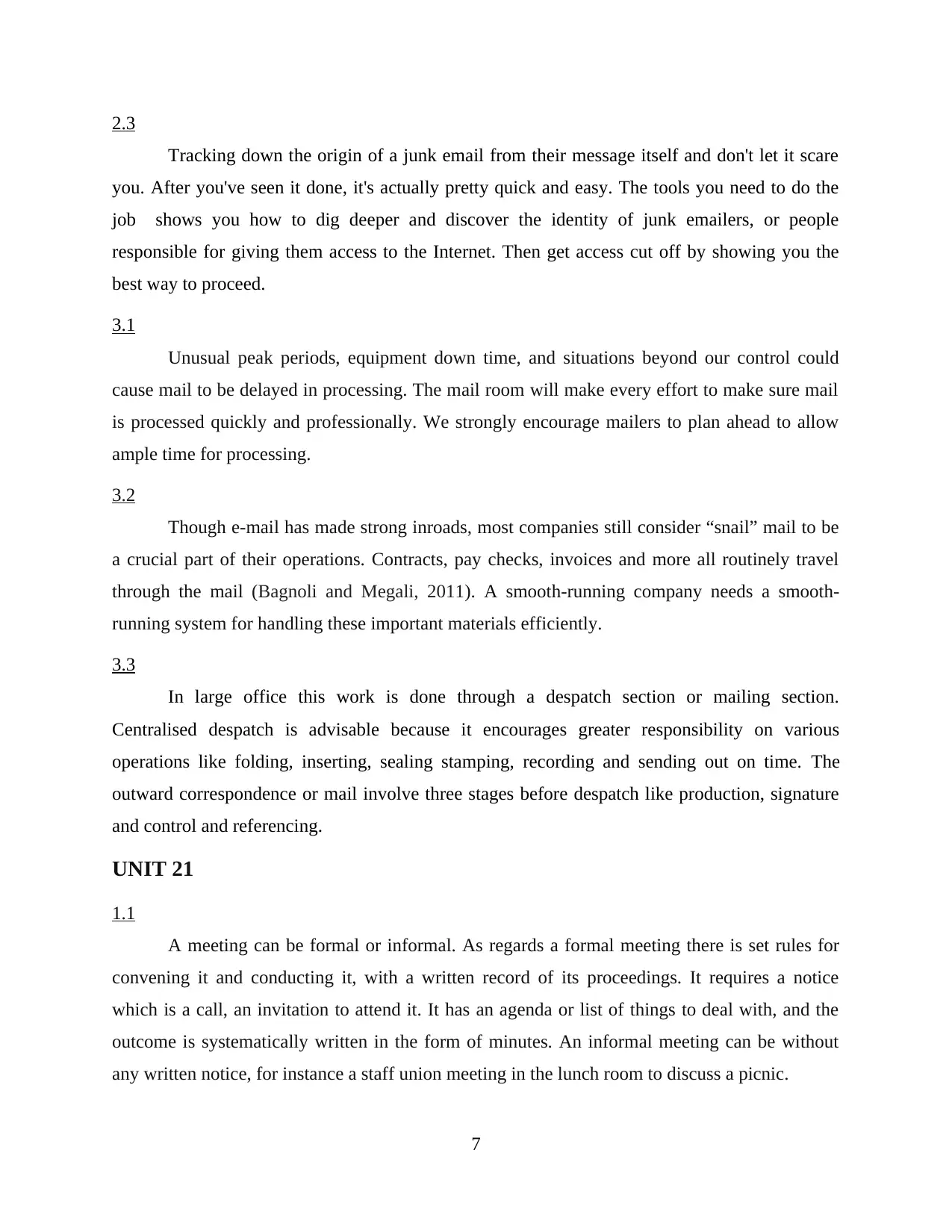
2.3
Tracking down the origin of a junk email from their message itself and don't let it scare
you. After you've seen it done, it's actually pretty quick and easy. The tools you need to do the
job shows you how to dig deeper and discover the identity of junk emailers, or people
responsible for giving them access to the Internet. Then get access cut off by showing you the
best way to proceed.
3.1
Unusual peak periods, equipment down time, and situations beyond our control could
cause mail to be delayed in processing. The mail room will make every effort to make sure mail
is processed quickly and professionally. We strongly encourage mailers to plan ahead to allow
ample time for processing.
3.2
Though e-mail has made strong inroads, most companies still consider “snail” mail to be
a crucial part of their operations. Contracts, pay checks, invoices and more all routinely travel
through the mail (Bagnoli and Megali, 2011). A smooth-running company needs a smooth-
running system for handling these important materials efficiently.
3.3
In large office this work is done through a despatch section or mailing section.
Centralised despatch is advisable because it encourages greater responsibility on various
operations like folding, inserting, sealing stamping, recording and sending out on time. The
outward correspondence or mail involve three stages before despatch like production, signature
and control and referencing.
UNIT 21
1.1
A meeting can be formal or informal. As regards a formal meeting there is set rules for
convening it and conducting it, with a written record of its proceedings. It requires a notice
which is a call, an invitation to attend it. It has an agenda or list of things to deal with, and the
outcome is systematically written in the form of minutes. An informal meeting can be without
any written notice, for instance a staff union meeting in the lunch room to discuss a picnic.
7
Tracking down the origin of a junk email from their message itself and don't let it scare
you. After you've seen it done, it's actually pretty quick and easy. The tools you need to do the
job shows you how to dig deeper and discover the identity of junk emailers, or people
responsible for giving them access to the Internet. Then get access cut off by showing you the
best way to proceed.
3.1
Unusual peak periods, equipment down time, and situations beyond our control could
cause mail to be delayed in processing. The mail room will make every effort to make sure mail
is processed quickly and professionally. We strongly encourage mailers to plan ahead to allow
ample time for processing.
3.2
Though e-mail has made strong inroads, most companies still consider “snail” mail to be
a crucial part of their operations. Contracts, pay checks, invoices and more all routinely travel
through the mail (Bagnoli and Megali, 2011). A smooth-running company needs a smooth-
running system for handling these important materials efficiently.
3.3
In large office this work is done through a despatch section or mailing section.
Centralised despatch is advisable because it encourages greater responsibility on various
operations like folding, inserting, sealing stamping, recording and sending out on time. The
outward correspondence or mail involve three stages before despatch like production, signature
and control and referencing.
UNIT 21
1.1
A meeting can be formal or informal. As regards a formal meeting there is set rules for
convening it and conducting it, with a written record of its proceedings. It requires a notice
which is a call, an invitation to attend it. It has an agenda or list of things to deal with, and the
outcome is systematically written in the form of minutes. An informal meeting can be without
any written notice, for instance a staff union meeting in the lunch room to discuss a picnic.
7
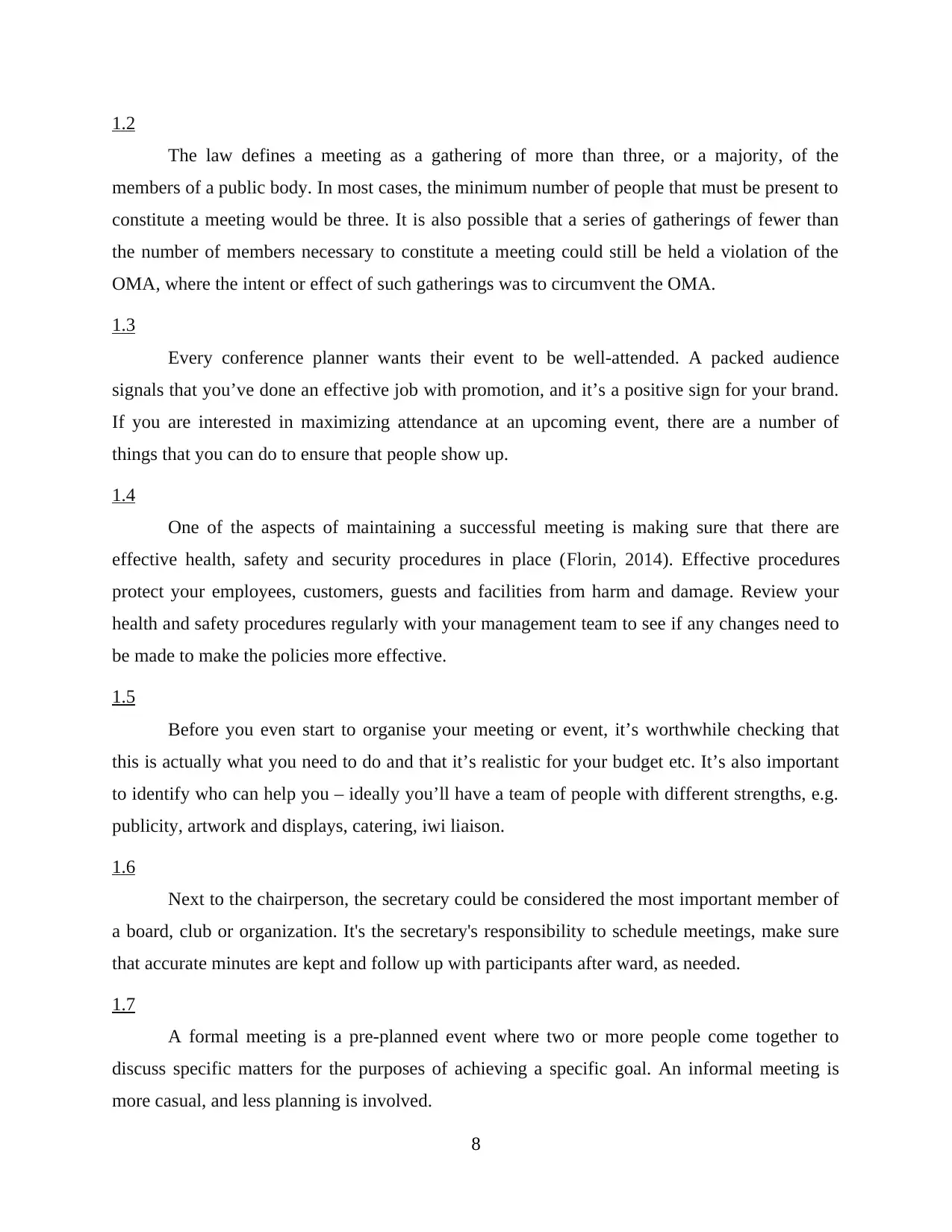
1.2
The law defines a meeting as a gathering of more than three, or a majority, of the
members of a public body. In most cases, the minimum number of people that must be present to
constitute a meeting would be three. It is also possible that a series of gatherings of fewer than
the number of members necessary to constitute a meeting could still be held a violation of the
OMA, where the intent or effect of such gatherings was to circumvent the OMA.
1.3
Every conference planner wants their event to be well-attended. A packed audience
signals that you’ve done an effective job with promotion, and it’s a positive sign for your brand.
If you are interested in maximizing attendance at an upcoming event, there are a number of
things that you can do to ensure that people show up.
1.4
One of the aspects of maintaining a successful meeting is making sure that there are
effective health, safety and security procedures in place (Florin, 2014). Effective procedures
protect your employees, customers, guests and facilities from harm and damage. Review your
health and safety procedures regularly with your management team to see if any changes need to
be made to make the policies more effective.
1.5
Before you even start to organise your meeting or event, it’s worthwhile checking that
this is actually what you need to do and that it’s realistic for your budget etc. It’s also important
to identify who can help you – ideally you’ll have a team of people with different strengths, e.g.
publicity, artwork and displays, catering, iwi liaison.
1.6
Next to the chairperson, the secretary could be considered the most important member of
a board, club or organization. It's the secretary's responsibility to schedule meetings, make sure
that accurate minutes are kept and follow up with participants after ward, as needed.
1.7
A formal meeting is a pre-planned event where two or more people come together to
discuss specific matters for the purposes of achieving a specific goal. An informal meeting is
more casual, and less planning is involved.
8
The law defines a meeting as a gathering of more than three, or a majority, of the
members of a public body. In most cases, the minimum number of people that must be present to
constitute a meeting would be three. It is also possible that a series of gatherings of fewer than
the number of members necessary to constitute a meeting could still be held a violation of the
OMA, where the intent or effect of such gatherings was to circumvent the OMA.
1.3
Every conference planner wants their event to be well-attended. A packed audience
signals that you’ve done an effective job with promotion, and it’s a positive sign for your brand.
If you are interested in maximizing attendance at an upcoming event, there are a number of
things that you can do to ensure that people show up.
1.4
One of the aspects of maintaining a successful meeting is making sure that there are
effective health, safety and security procedures in place (Florin, 2014). Effective procedures
protect your employees, customers, guests and facilities from harm and damage. Review your
health and safety procedures regularly with your management team to see if any changes need to
be made to make the policies more effective.
1.5
Before you even start to organise your meeting or event, it’s worthwhile checking that
this is actually what you need to do and that it’s realistic for your budget etc. It’s also important
to identify who can help you – ideally you’ll have a team of people with different strengths, e.g.
publicity, artwork and displays, catering, iwi liaison.
1.6
Next to the chairperson, the secretary could be considered the most important member of
a board, club or organization. It's the secretary's responsibility to schedule meetings, make sure
that accurate minutes are kept and follow up with participants after ward, as needed.
1.7
A formal meeting is a pre-planned event where two or more people come together to
discuss specific matters for the purposes of achieving a specific goal. An informal meeting is
more casual, and less planning is involved.
8
⊘ This is a preview!⊘
Do you want full access?
Subscribe today to unlock all pages.

Trusted by 1+ million students worldwide
1 out of 21
Related Documents
Your All-in-One AI-Powered Toolkit for Academic Success.
+13062052269
info@desklib.com
Available 24*7 on WhatsApp / Email
![[object Object]](/_next/static/media/star-bottom.7253800d.svg)
Unlock your academic potential
Copyright © 2020–2025 A2Z Services. All Rights Reserved. Developed and managed by ZUCOL.





